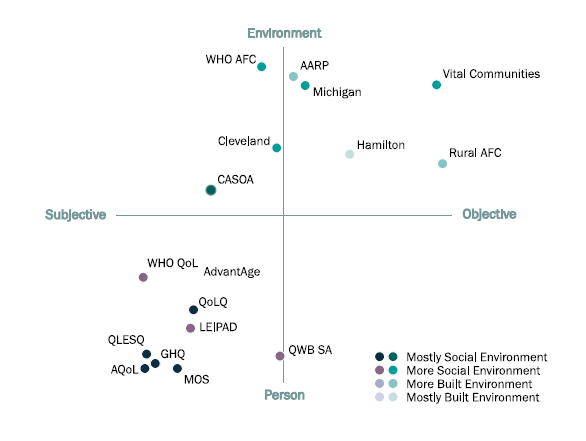This page is no longer current and is provided for archival and research purposes.
Appendix II: Age-friendly community and quality of life comparison
The needs assessment section of this tool kit (Section 5) includes general measures of QoL and instruments designed specifically for evaluating AFC. The graph on the next page compares the eight QoL instruments (purple) and nine AFC instruments (teal) in the tool kit on three separate factors important when designing an AFC needs assessment:
- How objective or subjective the instrument is.
- How dedicated the instrument is when comparing information about a person with information about the environment they live in.
- How dedicated environment-focused questions are when comparing information about the social environment with information about the physical environment.
For each factor, an instrument’s rating depends on the ratio of questions it contains that correspond to either end of the associated scale (for example, the proportion of objective and subjective questions). An instrument with questions only about the physical environment that are all assessed objectively would, therefore, appear in the top-right corner of the graph and with the lightest colour in the legend. (note: The label for each instrument corresponds with the names in the graphs in Appendix III.)
The tool kit provides several key differences between the QoL and AFC instruments.
Most notably, as a whole the QoL instruments are highly person-focused, while the AFC instruments tend to measure aspects of the community environment. As a result, the two types of instruments serve different purposes in a complementary relationship.
If you need a baseline assessment of your community’s physical and social infrastructure, then the AFC instruments are an appropriate source of relevant topics and questions. (Use these instruments if you want to ask questions such as ‘How accessible is the built environment?’ and ‘What social programs do older adults use?’) Alternatively, if finding out whether older adults are satisfied with their lives or they feel they need to improve their lives is important, then the QoL instruments are probably a better resource. (Use these instruments to ask questions like: ‘How safe do older adults in the community feel?’ ‘How economically secure are older adults?’)
An equally important difference is the form of measurement each instrument type uses. As the clustering of the purple markers toward the left of the scale suggests, QoL instruments generally contain a higher number of subjective items when you compare them to the more objective AFC tools. While you might view this as a weakness, this trend is in no way a function of poor instrument design. The health care profession’s reaction to disease-centred care models traditionally neglected life satisfaction as an element of good practice. Current QoL instruments base their measurements of health-related QoL on this. As a result, subjective instruments are now the accepted norm for measuring QoL because ‘QoL resides within the experience of the individual.
The final general distinction between the QoL and AFC instruments relates to the issue of measurement, something not immediately visible in the graph. Although many of the AFC tools were created as a community-wide survey (for example, AdvantAge; CASOA), certain instruments were designed as audits for a small project team to complete (for example, AARP; Cleveland). These audit instruments cover a broad range of important issues and are a great resource for identifying relevant AFC topics; however, in many cases, you need to reword their questions to use them in a community-wide survey. Alternatively, all of the QoL instruments below were developed as self-administered or evaluator-administered surveys. In most instances, the wording of their questions is appropriate for a community-wide survey. For more detailed information about developing and using each instrument and their strengths, see the instrument descriptions and graphs in Appendix III.
Needs Assessment Comparison

Footnotes
- footnote[20] Back to paragraph Diener, E. (2009). Assessing subjective well-being: Progress and opportunities. Social Indicators Research Series 39: pp. 25–65.